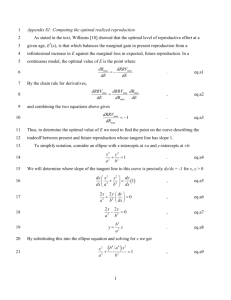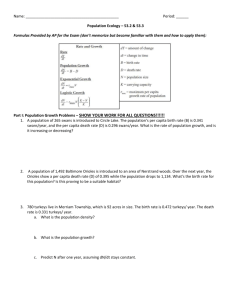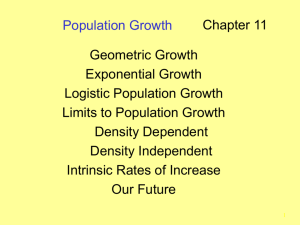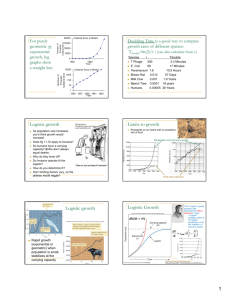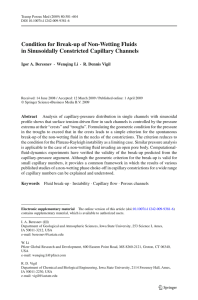PowerPoint - Susan Schwinning
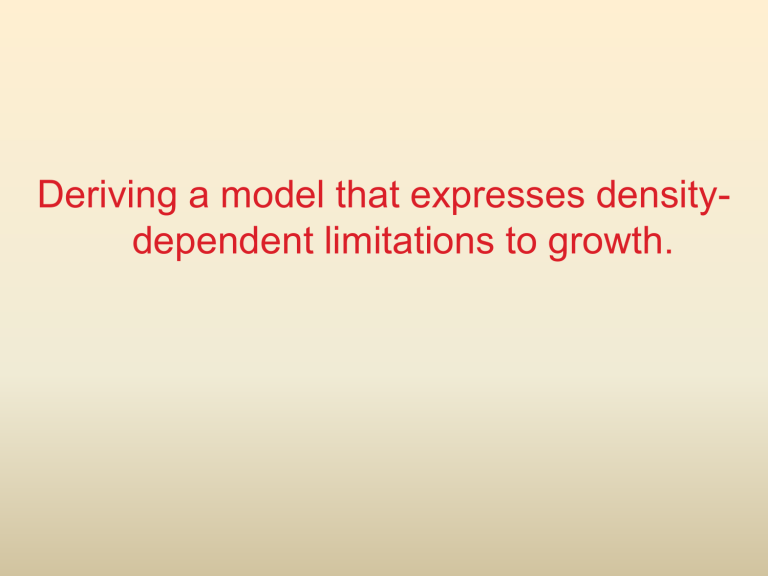
Deriving a model that expresses densitydependent limitations to growth.
This is unchecked growth: dN
rN dt where r is a constant
In “checked” population growth, the factor multiplied with N can’t be a constant: dN
f ( N ) N dt
f ( N ) r max s
N
K d N
d t f ( N ) N d N
( r max
sN ) N d t s
r max
K d N d t
( r max
r max
K
N ) N d N d t
r max
N
1
N
K
The Logistic Growth Model d N d t
r max
N
1
N
K
2 parameters: r max
: the intrinsic (or maximal) per capita rate of growth
K: the carrying capacity
r max
b max
d min
Birth rates can decline with population size.
d or b b max
Death rates can increase with population size.
d min
K
N
The Logistic Growth Model
Pierre-Fran çois Verhulst
Belgian mathematician
(1804 – 1849)
Plug & Play
Excel Worksheets :
• Logistic Growth
Three graphical representations of the
Logistic Growth Model
N
K dN dt dN
N dt r max t
“Time series” or
N vs. time
N K absolute population growth rate vs. N
N
K relative population growth rate vs. N
dN dt
N
K
1.
Identify on this graph all population sizes where the population growth rate is zero.
2.
Identify the range of population sizes over which population size increases.
3.
Identify the range of population sizes over which population size decreases.
dN dt
Growth rates are positive here. Population change in this direction:
N
Zero Growth
K
Growth rates are negative here.
Population change in this direction:
Definition of an “equilibrium state”:
The equilibium state of a population is the population size (N*) where the population neither increases nor decreases.
d N
0 d t
1.
Calculate the equilibria of the logistic growth model: d N d t
r max
N
1
N
K
The Logistic Growth Model has two equilibria: d N d t
r max
N
1
N
K
N* = 0, also called the “trivial equilibrium”.
N* = K is not trivial. A population of size K will neither decline of increase.
Definition of a “stable equilibrium state”:
An equilibrium N* is said to be locally stable if population sizes that are slightly smaller or slightly bigger move back towards the equilibium.
For small positive
: if N
N *
then if N
N *
then dN
0 dt dN
0 dt
Definition of a “stable equilibrium state”:
An equilibrium N* is said to be globally stable if population sizes that have any other size than N* move towards the equilibium.
For any positive
: if N
N *
then if N
N *
then dN
0 dt dN
0 dt
dN dt
N d N
0 (equilibria) d t
K
dN dt
This equilibrium is unstable!
This equilibrium is globally stable!
Growth rates are positive here. Population change in this direction:
Growth rates are negative here.
Population change in this direction: N d N
0 (equilibria) d t
K
The Logistic Growth Model has two equilibria: d N d t
r max
N
1
N
K
N* = 0, the “trivial equilibrium” is unstable!
N* = K is globally stable!
That means populations following the logistic growth model will always approach the carrying capacity K.
Summary:
1. The logistic model is the simplest model that expresses limits to population growth.
2. It assumes that the per capita population growth rate (dN/(Ndt)) declines linearly with population size N.
3. The logistic model has two parameters:
• r max is called the intrinsic rate of growth. It expresses the maximal growth rate a population can achieve when at low density.
• K is called the carrying capacity. It expresses the stable population size where birth rates = death rates.
4. The logistic model has one non-trivial, globally stable equilibrium in K.
